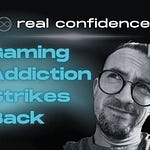“Alright, this is my last one… After this, I’m done…”
Ever gave yourself that ultimatum, only to void the contract soon after it was created?
If so, you are not alone.
These tools are the lessons learned from my mistakes.
#5 helps you cultivate a growth mindset.
It’s a cunning counter to immediate gratification, a well-kept secret the dopamine dealers don’t want you to know.
So of course, I’m revealing it.
#6 helps you stick with habit changes, without going back on yourself.
You give up the booze for 2 weeks. But then, the slippery ‘elixir of life’ somehow finds its way back into your life…
Time to get a better slice of pie – habit pie that is.
Sound good? Let’s dig in.
Q: How can I stop giving in to temptation?
A: With a Dynamic Decision…
Tool #5: Dynamic Decision
What is it?
Every decision we make, big or small, impacts us – either moving us forward or holding us back.
So, how does this play out in everyday life?
Let’s say you’re deciding what to have for dinner. You have two options:
a) Order a burger and fries.
b) Prepare a salmon fillet with mash and vegetables.
The burger is quick, tastes great, and satisfies your craving right now.
Sure, a one off is fine. But over time, if you keep choosing convenience, the effects add up.
Think clogged arteries, weight gain, and a body that doesn’t feel good.
On the other hand, cooking the healthier meal takes more effort and might not provide that immediate rush of pleasure…
But if you consistently make that choice, the long-term rewards are undeniable:
Better physical health, mental clarity, and a body that feels strong.
This is the Dynamic Decision.
The ongoing choice between ‘immediate you’ and ‘future you’.
How to apply it?
Ask yourself:
Do I value the present moment more than my future?
Do I want to feel better now at the expense of my future self?
Am I willing to invest in my future to reap greater rewards later?
Visualise your future self watching you right now. Cheering you on, supporting you, believing in you.
Every decision you make today affects them. Your future self is constantly evolving based on the choices you make in the present.
When making decisions, prioritise your future self.
If you don’t, you risk facing regret when the future arrives after the damage is already done.
This is not to say you should never indulge yourself. Do, but do it consciously.
Use indulgence like salt. A little goes a long way. But too much, too often and you will pay the price.
Remember, when you delay gratification, the payoff grows.
It’s not always easy, but your rewards compound over time.
Why it works?
By understanding what we don’t want, we gain clarity on what we do want.
If we don’t want to be unhealthy and unfit in the future, we can start taking steps now to prevent that from happening.
Viewing each decision this way helps us see the real impact of our choices – it forces us to take responsibility.
We’re not just making choices for ourselves in the moment; we’re also making them for our future selves, who are counting on us to make the right decisions today.
That sense of responsibility makes us pause and reconsider.
It encourages us to invest in our future rather than sacrificing it for short-term desires.
It’s this shift that turns everyday decisions into opportunities for long-term growth.
Start making dynamic decisions and watch the results rack up.
Speaking of results…
Are you subscribed?
If you are ready to enter the room, instead of watching from the outside…
Join the movement now.
Subscribing gets you a copy of the Confidence Codex, your A-Z of building real confidence. Find it in your welcome email.
Plus, subscribers can reply to emails, send messages and ask questions.
This is where you stop consuming content and start creating connection.
Q: I tried to quit, but the habit came back. Why?!
A: Because you’re missing a slice of Habit Pie…
Tool #6: Habit Pie
What is it?
Ever played Trivial Pursuit? That board game where you fill segments by answering questions…
This tool was inspired by it.
Imagine your life as a pie, with each slice representing a habit.
When the pie is full, you’ve reached your capacity. Your time and energy are fully occupied, and there’s no room for anything else.
When you want to change a habit – let’s say you want to quit smoking – you have to remove that slice from your pie.
But there’s a catch…
If you don’t replace that empty space with a new, positive habit, the old habit will slide right back in.
The pie is like a vacuum, it craves to be whole (because no one likes a half-eaten pie).
When there’s an empty space, it naturally pulls something back in to fill the void. That’s why it’s important to fill that space with something fulfilling.
Otherwise, you might just find yourself back where you started.
How to apply it?
When you decide to change a habit that no longer serves you, the time you free up is unclaimed.
It’s up for grabs, and if you don’t give that time a new purpose, the old habit will try to take it back.
Think of bad habits as a clingy exes.
They don’t like being ignored and will keep trying to win back your attention.
If you don’t actively fill that time with something new, those bad habits will keep slipping back into your life.
The secret is taking time you’ve reclaimed and filling it with something meaningful.
Go for walks in nature, sign up for art classes, or dive into a new hobby. Just don’t leave that time empty, expecting the old habit to disappear on its own.
If you don’t fill the space, the habit will.
Why it works?
The pie acts like a vacuum, it wants to be whole.
When you remove a habit, it naturally wants to pull something back in to fill the empty space.
If you replace the old habit with a new, positive one, the pie becomes whole again, leaving no room for the old habit to sneak back in.
The key is to nurture this new habit until it becomes a solid part of your life.
The longer you stick with the change, the more it becomes a part of who you are.
This is called an identity shift, where you stop associating with the old habit on a personal level.
Instead, you identify with the new habit, integrating it into who you are.
What can this look like?
“I’m a smoker.” (Identity)
I’m trying to quit smoking.” (Removing the bad slice)
“I’m not a smoker.” (Empty slice)
“I’m learning the drums” (Replacing the slice)
“I’m a drummer.” (New identity)
It’s with this new identity and solidified activity, there is no room left for the habit we removed to come back.
You just cleaned up your habit pie, into something more fulfilling and long lasting.
Next time on the Transformation Toolbox…
Tools #7 and #8 will be making an appearance.
Part Breakdown and Passenger Paradox.
Next week you’ll discover how to:
Turn immovable objects into mere bitesize chunks.
Stop hesitating in-front of big goals and smash them instead.
Ensure you don’t ride the train of life all the way to Neverland.
Build your dream instead of being part of someone else’s.
Until then, take care.
At your side, always.
–ONM
If you missed the previous episodes, catch up here:
Part 1:
Part 2:




















Share this post